UMET - Sample scientific grants
Projet COMASYS
2021-2030
Créé en 2021, le projet COMASYS « Continuum de l’énergie : du matériau aux systèmes » s’appuie sur l’expertise de plusieurs laboratoires du site de l’Université de Lille*. Ce projet est articulé autour de 4 piliers thématiques (récupération de l’énergie, stockage de l’énergie, production et valorisation de l’hydrogène, réacteurs nucléaires modulaires avancés) avec un socle méthodologique et des démonstrateurs internes communs. Financé par l'Université de Lille, initialement via la fondation I-SITE ULNE puis dans le cadre de France 2030, COMASYS se veut à l’interface entre le HUB 2 « Innovation au service d’une planète en mutation » et le HUB 3 « Monde numérique au service de l’humain ». COMASYS travaille à proposer des avancées dans le domaine de l’énergie en s’appuyant sur les expertises fondamentales allant du domaine des matériaux à la conception des systèmes. Il s’agit d’un projet de recherche transversal qui vise à attirer des étudiants de divers horizons via des projets de thèse, master et postdoctorat. COMASYS permet de renforcer les interactions entre les différents partenaires locaux et de conforter les liens avec la Région Hauts-de-France et les différents pôles de compétitivité et d’excellence. Deux équipes de l’UMET sont impliquées dans ce projet : - L’équipe ISP est impliquée dans le pilier 1 sur la récupération d’énergie mécanique via des matériaux piézoélectriques et d’énergie thermique via des matériaux thermoélectriques. - L’équipe MPGM intervient au niveau du pilier 4 « réacteurs nucléaires modulaires avancés » pour l’étude de la tenue des matériaux de structure en présence de sels fondus. Created in 2021, the COMASYS project "Continuum of Energy: from material to systems" draws on the expertise of many laboratories on the University of Lille site*. This project is structured around 4 thematic pillars (energy recovery, energy storage, hydrogen production and recovery, advanced modular nuclear reactors) with a common methodological base and internal demonstrators. Financed by the University of Lille, initially by I-SITE ULNE (a certification label of Excellence for Lille Nord-Europe University) and then as part of France 2030, COMASYS is intended to be at the interface between HUB 2 « Innovation in the service of a changing planet†and HUB 3 “Digital world in the service of peopleâ€. COMASYS works to propose advances in the field of energy by drawing on fundamental expertise ranging from materials to system design. It is a cross-disciplinary research project that aims to attract students from diverse backgrounds via thesis, master's and post-doctoral projects. COMASYS will strengthen the interactions between the various local partners and reinforce the links with the Hauts-de-France Region and the various competitiveness and excellence clusters. Two UMET teams are involved in this project: - The ISP team is involved in pillar 1 on the recovery of mechanical energy via piezoelectric materials and thermal energy via thermoelectric materials. - The MPGM team works on pillar 4 “advanced modular nuclear reactors†to study the behavior of structural materials in the presence of molten salts. *CRIStAL, GEMTEX, IEMN, L2EP, UCCS, UMET, CHEVREUL, IRCICA
HORIZON-JU-CBE-2023-IA-05 SurfToGreen
2024-2029
Formulations in industrial applications primarily rely on fossil-based surfactants/polymers significantly contributing to environmental pollution (CO2 increase, microplastics) and are scarcely sustainable. The EU Green Deal demands for new chemistries based on sustainable and natural compounds. Effective bio-based surfactants are poorly integrated in industry and in their infancy in research. SurfToGreen will fill this gap with a completely new surfactants platform covering diverse industrial applications to replace current surfactant benchmarks. SurfToGreen gathers a unique partnership of major industrial actors and excellence research centers, with the advanced knowledge on soft matter and industrial processes fundamental to achieve this challenging goal. Biomass derived building blocks will be obtained from EU territorial value chains, including forests and agriculture waste/side streams to diversify biomass origin, and used to synthesize novel biobased surfactants. The new products will cover anionic, nonionic, cationic, zwitterionic surfactant families, and biopolymers-oligomers from renewable sources with no impact on the food chain. The platform will be validated in three industrial demonstrators among the most fast-growing crucial sectors, i.e., home/personal care, textile, and agriculture. The compounds’ surface properties will be assessed against detergency, interfacial, and rheological behaviour. Polymers/ oligomers, hydrotropes and surfactants will be used for encapsulation to protect and control the delivery of actives (perfumes, and compounds for plant protection). Digital technologies and safe-and-sustainable by design methodologies will assess the functionality, safety, and sustainability of the biobased formulations within a circular value chain framework. Finally, extensive exploitation and commun
INTERREG INSIDE 3D
2024-2028
projet INTERREG France - Wallonie - Vlaanderen – Inside 3D : Développer les capacités hospitalières en impression 3D pour améliorer la prise en charge des patients et optimiser la formation des praticiens. Le projet INTERREG Inside 3D, piloté par le CHU de Lille, a pour mission de répondre à un besoin clinique majeur dans le cadre de la médecine personnalisée : améliorer la qualité des soins aux patients et renforcer la formation des étudiants en médecine sur notre territoire transfrontalier. Objectifs du projet : Notre objectif est de déterminer, sur la base de cas d’étude et démonstrateurs analysés sur les plans réglementaires, ergonomiques, médicales et socio-économiques, la place de la production intra-hospitalière par impression 3D pour : i) des modèles pédagogiques, ii) certains dispositifs médicaux (DM) sur-mesure, iii) médicaments personnalisés. Ces productions viendront en complément de l’offre médicale existante, pour répondre aux besoins des patients et des professionnels de santé. Pourquoi INSIDE 3D est essentiel ? 1/ Répondre aux besoins hospitaliers spécifiques : aujourd’hui, l’impression 3D est souvent externalisée, engendrant des délais importants et des coûts élevés, incompatibles avec des soins urgents. INSIDE 3D propose une solution directe : Permettre aux hôpitaux de développer une stratégie d’impression 3D adaptée à leurs contextes, permettant de répondre aux besoins cliniques, tout en optimisant les coûts et les délais. 2/ Un impact concret pour les patients et les professionnels : l’impression 3D dans les hôpitaux permettra : • Une prise en charge plus rapide et personnalisée, • Des outils pédagogiques avancés pour la formation des soignants, • Des innovations pour améliorer l’organisation hospitalière et la qualité des soins. * Une démarche transfrontalière : Notre projet rassemble des acteurs clés de l’impression 3D en santé, incluant des universités, des centres de recherche et des hôpitaux en France, en Wallonie et en Flandre. Inside 3D s'articulera autour de 7 modules de travail traitant des volets socio-économiques, réglementaires mais également techniques. Cette collaboration européenne garantit une approche complète intégrant des perspectives variées pour répondre aux enjeux des systèmes de santé. Ce que INSIDE 3D apportera : 1. Des démonstrateurs concrets : outils et processus testés dans des hôpitaux pilotes. 2. Des cas d’étude pratiques : pour aider les gestionnaires à prendre des décisions éclairées sur l’adoption de l’impression 3D. 3. Des recommandations stratégiques : intégrant le cadre réglementaire européen et les meilleures pratiques. 4. Une amélioration globale : bénéfices mesurables pour les patients, les professionnels et l’organisation hospitalière. Début du projet: 1er octobre 2024, Durée: 4 ans, Budget: 6,3 M€. Coordinateur: CHU Lille (France); Partenaires: Umons (Wallonie), ULille (France), Centrale Lille (France), UGent (Flandre), Eurasanté (France), UZGent (Flandre), Certech (Wallonie), CNRS (France), VIVES Zuid (Flandre), BCRC (Wallonie)
Interreg CIRCOPLAST
2024-2028
Le projet Interreg VI, CIRCOPLAST vise à permettre le recyclage des plastiques contaminés par des retardateurs de flamme bromés (non conformes aux normes REACH) grâce à une technologie d'extraction innovante pour éliminer les retardateurs de flamme bromés des déchets plastiques. Ce projet CIRCOPLAST, faisant suite au projet INTERREG FWVL VALBREE, se concentre sur le développement d'un processus vert et innovant sans utilisation de solvants toxiques et en utilisant des technologies de pointe (fluides supercritiques, rayonnement UV-visible et processus enzymatiques). Le projet CIRCOPLAST étudiera si le processus discontinu peut être converti en un processus d'extrusion continu et recherchera des synergies avec d'autres techniques de décontamination. À cette fin, une extrudeuse à double vis sera équipée de lampes UV-visible, d'une zone où l'extraction du scCO2 est possible et des co-solvants seront ajoutés de manière à permettre l'extraction des composants bromés au cours du processus d'extrusion. En outre, un recyclage biologique/enzymatique sera mis au point pour recycler les matériaux en polyuréthane, qui sont aussi souvent considérés comme des polymères difficiles à recycler et fonctionnalisés avec divers retardateurs de flamme interdits. Un deuxième pilier important du projet est le développement d'une nouvelle génération de formulations de polymères basées sur des blocs de construction recyclés, d'une part, et des blocs de construction durables d'origine biologique, d'autre part. Ce deuxième projet pilote utilisera donc des blocs de construction de lignine biosourcés pour produire une nouvelle génération de polymères et de retardateurs de flamme. Chercheurs impliqués : Ulrich Maschke, Philippe Supiot, Corinne Foissac. Budget total: 2.89 M€. Durée : 48 mois.
Interreg SAFE
2024-2028
Le projet SAFE a pour objectif d’élaborer et de combiner des technologies de traitements de surface par voies plasma et sèche pour microstructurer et nanostructurer des surfaces de biomatériaux en titane destinés à la fabrication d’implants médicaux afin d’en améliorer les propriétés fonctionnelles telles que l’ostéointégration.
Interreg THERMOHARV
2024-2028
Le projet ThermoHarv s’inscrit dans le contexte de l’économie d’énergie, l’un des enjeux majeurs actuel. L’objectif du projet est la récupération de la chaleur fatale, ou chaleur perdue au sein des bâtiments. Les technologies utilisées au cours de ce projet sont la thermo- et la pyro-électricité, qui permettent de convertir respectivement un gradient de chaleur spatial et temporel en énergie électrique de faible puissance. Cette énergie sera utilisée pour alimenter des dispositifs peu énergivores tels que des capteurs ou les objets de l'IoT (Internet of Things). Les matériaux et les procédés utilisés sont transposables à l’industrialisation (plasturgie, revêtement, impression 3D...). Le recyclage des matériaux est aussi un aspect important et contribue aux valeurs écologiques du projet.
ANR JCJC RESSET
2024-2028
At first sight there is limited room for steel recycling improvement as the recycling rate is already quite high (90%). However, this rate does not account for downcycling aspects. Indeed, recycling a material does not mean that its application is as prestigious as originally. New alloys are thus processed to fulfill the need for structural and functional materials, generating a large part of the CO2 emission over the world. The fact that materials are not simply reused is partly related to sorting issues. The industrial technology lacks maturity to completely differentiate the huge diversity of grades ending up to scrap dealers. Consequently, steel scrap becomes a mix of grades that does not have the composition the research and material development have focused on so far. In turn, the scrap is either mixed with primary chemical elements from ores to return to a well-known composition, or transformed into material parts for which the specifications are less strict. From a sustainability perspective, it is needed to take care of this scrap. The RESSET project aims at avoiding steel scrap downcycling by exploring new thermomechanical routes leading to improved mechanical properties in presence of contaminants, like Cu, and using materials design concepts. The RESSET framework specifically intends for precipitation sequences able to strengthen the material. To fulfill this objective, modelling tools describing phase transformation kinetics depending on processing conditions and for the constrained scrap composition will be developed. Thermodynamics and kinetics-based derivations will provide criteria for precipitation initiation, equations for precipitate growth and coarsening, and will be coupled with other phase transformations of interest in steels, namely the martensitic transformation or the austenite reversion. To make the framework fully generic, governing equations will be coupled with thermodynamic and kinetic databases. The best processing conditions leading to selective precipitation of contaminants and material strengthening will be found with an optimization algorithm. Experimentally obtained microstructure of a model alloy subjected to a thermomechanical treatment and which composition will be fixed by a typical scrap composition will be investigated to get insights into the microstructure evolution during the processing to help the fundamental model development. These microstructures will finally be compared to the modelling tool predictions in order to validate it and to use it to help steel recycling by providing new solutions.
Cefipra Centre Franco-Indien pour la Promotion de la Recherche Avancée
2022-2027
Elucidating polymorphic behaviour of active pharmaceutical ingredients (APIs) during crystallization: A combined approach of experimental and molecular dynamics simulations studies
ANR PRC NanoBAP
2023-2027
Les innovations dans le domaine de l’emballage alimentaire visent à prolonger la durée de vie des aliments tout en garantissant la sécurité du consommateur. Elles concernent surtout le développement d’emballages actifs. Les polymères biodégradables et biosourcés ainsi que les composés antimicrobiens naturels garantissent une approche durable pour l’emballage alimentaire. L’objectif du projet NanoBAP est de démontrer le potentiel des nanofibres électrofilées dans le domaine des emballages actifs, à travers le développement d’un revêtement antioxydant et antimicrobien à base de matériaux biosourcés appliqué sur un film de PLA pour la libération combinée de plusieurs composés naturels bioactifs. Deux stratégies basées sur l’électrofilage seront entièrement étudiées : de la conception de films à biodégradabilité variable, la caractérisation des propriétés physico-chimiques des films revêtus et les mécanismes de libération/transfert des composés antimicrobiens jusqu’à l’évaluation de l’activité antimicrobienne in vitro et sur un modèle alimentaire. La solution innovante finale sera d’importance majeure pour l’emballage d’aliments frais tranchés ou texturés. En conclusion, ce projet permettra une avancée majeure à la fois scientifique et économique, en générant des emballages actifs 100% bio-sourcés et biodégradables permettant de réduire considérablement la pollution d’origine plastique et le gaspillage alimentaire. Ce projet est réalisé en partenariat avec l'UMR PAM (Université de Bourgogne-Europe) et l'UCEIV (Université du Littoral-Côte d'Opale)
ECOS SUD ARGENTINE
2024-2027
The project aims to provide a new and versatile foam technology platform for detecting a wide range of biochemical markers and chemical contaminants. This project aims to demonstrate the proof of concept of how responsive foam-based systems could be a new detection method for various applications: (1) In the food industry, for the detection of bacteria. (2) In medicine, for the detection of biomarkers such as bile salts, cholesterol, or enzymes. (3) In environmental monitoring, for the detection of contaminants such as pesticides. Foam sensors would offer a variety of potential advantages in terms of speed, cost, and ease of handling for in-situ detection, in a first rapid real-time test. The hypothesis at the outset of the project is that the presence of biomarkers or contaminants can interfere with the surfactant system's ability to produce and stabilize foams. We will utilize changes in foam-forming capacity, or foamability, as a reading mechanism, which is a visible alteration and can be measured with a simple ruler (refer to Fig. 1). To achieve this, we need to identify the optimal conditions for obtaining foams with two distinct behaviors in the presence and absence of the biomarker being sensed, namely high/low foamability. Foam-forming capacity is contingent on the kinetics of adsorption, surface coverage or concentration, and surface elasticity resulting from the presence of surfactants, among other physicochemical properties. The project's roadmap is to formulate the chemical system such that the interaction between the biomarker and the surfactant modifies one or more of these dynamics, which would subsequently impact foamability. In order to achieve this, we must understand the physical and physicochemical mechanisms that govern the bulk assembly and interface interaction of surfactant-biomarker complexes, and how they correlate with the aforementioned dynamics, as well as the stability and foamability of the foams produced using these complexes. As an objective in cooperation between the participating groups, the first and obvious one is to establish the first links between the UMET unit in Lille and the Physics Institute of the South (CONICET - UNS) in BahÃa Blanca. The second objective is to improve the project outcomes by leveraging the complementary knowledge, experience, and resources of both groups. The French groups bring their expertise in the chemical systems under study and their applications in the industries mentioned, while the Argentine group contributes their expertise in foam physics, including the development of novel experimental techniques and their experience in responsive complexes. However, the primary focus of the project is to provide cross-training opportunities for doctoral and postdoctoral students from both groups.
ESA OIL FOAM
2024-2027
Aqueous foams are encountered in many commercial products used in our everyday lives and are widely studied. By contrast, non-aqueous foams are scarcely studied despite the fact that they are as important as aqueous foams, and play important roles in various industries and processes, such as food, cosmetic, pharmaceutical, petroleum and lubricants industries. Also in space, foams are expected to play an important role in all the processes required for human exploration like liquid/gas separation in life support systems, food production or propellant management. Liquid foams are dispersions of gas bubbles in a liquid phase. Because of the large density difference between air and the liquid, this liquid drains rapidly due to gravity and dry foams are obtained. Furthermore, coarsening and coalescence are coupled with gravity drainage and are faster when the foam liquid fraction is lower. These foam destabilization mechanisms have been widely studied for aqueous foams on Earth and under microgravity conditions. However, for non-aqueous foams, we still know little about drainage, coarsening and coalescence, a serious drawback for developing further their applications by predicting their behavior and stability. The aim of our project is to study the behavior of different non-aqueous foam systems used or encountered for specific applications (food, cosmetic and lubricants) in microgravity in order to study their foamability and to suppress drainage, and gain insight into the stabilization mechanisms of these wet foams in terms of coarsening.
ANR PRC COOLISSE
2023-2027
Secondary refrigeration is an effective way to drastically reduce the quantity of primary refrigerant fluid used while improving energy efficiency by storing and transporting energy-dense secondary fluids. These ice slurries, composed of ice crystals suspended in an aqueous solution are unfortunately not yet widespread because of the over-investment related to scraped surface or supercooling type generators. Within this COOLISSE project, our objective is thus to participate in the modernisation of the sector refrigeration by designing new type of ice slurry generators. Our aim is therefore to develop stainless steel surfaces where formed ice could be carried away by the fluid flow, without the need of any mechanical scraping. These original non-wetting micro/nanostructured surfaces, inspired from nature, with anti-icing properties will be obtained by a combination of two original and efficient processes: additive manufacturing (to yield micro-structures) and femtosecond laser ablation (to reach nanometer scale roughness) that will allow obtaining a multiscale and very dense textured stainless steel surface. These surfaces will be then infused by inert liquid in order to obtain slippery infused surface (SLIPS). The second objective of the project is to develop methods and expertise on the surface characterization under flow at low temperature [-15°C to 0°C]. The potential in anti-icing applications of the designed surfaces will be proven by investigating their action mechanisms on ice formation, analysing the freezing time, adhesion strength and nucleation in the freezing process. In parallel a comprehensive numerical method will developed to describe the thermal equilibrium state, heat flux and gas-solid-liquid interface changes during freezing and phase change. The environmental impact and potential gain of these new surfaces on slurry fabrication process will also be compared to traditional processes using multiple criteria analyses like Life Cycle Analysis

ERC HotCores - Revealing the unknown planet within the Earth
2022-2027
The Earth’s inner-core (IC) is 1220 km radius planet within the Earth, made of solid iron (Fe) crystallizing from the outer core (OC) as the Earth cools down. Geophysical observations unearth the IC as it is today. Understanding the history of the IC and the effect of the IC on the global Earth dynamics, however, requires a reconstruction based on today’s observations and knowledge of the physical properties of the IC Fe alloy, how they could affect IC dynamics, and their relation with present-day geophysical observables. There are significant knowledge gaps and outdated principles regarding the underlying physical properties of the IC Fe alloy. In HotCores, advanced high pressure and/or high temperature experiments will be performed on Fe alloys and analogues. We propose to reenact key events of the history of the IC in the laboratory, as Fe crystallizes at the inner-outer-core boundary, as the IC grows and dynamically evolves to its present state, and as we see it today through the lenses of geophysical exploration.
EXPLOR’AE SENSOFOAM
2024-2026
This project aims to show the proof of concept of how liquid foams based on responsive surfactant systems could be a new detection method in the food industry for bacterial and pesticides detection. Foam sensors would be an easy on-site detection method for the operators working in the food chain production with potential advantages in terms of speed and cost.
ANR JCJC SOGLOSSI
2022-2026
Food losses is responsible for unnecessary greenhouse emissions and waste of resources such as water, land, energy and inputs. Therefore, limiting food losses is of major interest to limit climate change and ensuring food security and sustainability. Nearly one-third of all food produced worldwide is estimated to be lost postharvest, and much of this loss can be attributed to microbial spoilage. The spore-forming bacteria of the Bacillus subtilis group (B. subtilis) are among the most commonly identified species in the spoiled heat-treated food such as bakery and dairy products leading to high economic losses for the food and feed industry. The recurrence of Bacillus contamination is largely due to their ability to sustainably contaminate surfaces, particularly because of the spores' ability to strongly adhere to all types of materials and to resist hygiene procedures. To control this food-spoilage agent, it is therefore required to better describe the surface layer of spores interacting with contact materials of processing plant facilities. In B. subtilis, this layer is mainly made of proteins and glycans. While the crust proteins and their interaction network are now well established, the localization, nature and structure of glycans remain almost unknown. The SOGLOSSI project proposes a multidisciplinary approach combining microbiology, genetic, glycobiology and fluid mechanics at laboratory and pilot scale to I/ characterize the structure and the anchoring of the crust glycans of B. subtilis, II/ evaluate the role of each glycan in spore / contact material interactions and III/ evaluate the impact of processing and hygiene procedures on spore surface glycans and their consequences on spore / contact material interactions. To address the first objective, the crust glycans of several B. subtilis strains (including strains isolated from food industry) will be separated by chromatography and the structure of each glycan will be resolved by the combination of mass spectrometry and NMR methods. The putative glycosylation sites of the crust proteins will be defined by directed mutagenesis and glycoproteomic approaches. To address the second objective, the crust glycans structure of several mutant stains (available at PIHM) will be resolved by the methodology described above and the spore / contact material interactions forces will be measured for each mutant by using a flow-cell. These parallel approaches will make it possible to define the role of each glycan in the interactions between spores and contact materials. To address the last objective, a dedicated test rig will be manufactured to submit B. subtilis spores to conditions encountered in food processing (flow rate, temperature, pH) and evaluate the impact of these parameters on spore glycans and the consequences on spore adhesion. This knowledge will be used to develop alternative production and cleaning methods that are more effective in terms of surface hygiene control and more environmentally friendly, such as flow foam cleaning with bio-based surfactants that will be tested on a pilot scale. This project will generate fundamental knowledge about the structure and properties of the surface glycans of B. subtilis spores. It will also have major economic and environmental outcomes. The data obtained through this project could be used to optimize transformation and hygiene procedures in the food processing industries that faced recurrent contamination by spore-forming bacteria of the B. subtilis group. They should also help to develop mild-processing techniques and green hygiene solutions which are essential I/ to reduce the economic and environmental impact of these processes and II/ to improve the organoleptic, nutritional and health quality of processed food while limiting food spoilage.
Chaire industrielle Proteinopeps
2022-2026
Du fait de la concurrence croissante entre les protéines laitières et végétales et des nouveaux désidératas des acteurs de la filière protéine laitière pour se diriger vers des produits « clean label » authentifiés, les fabricants d’ingrédients doivent diversifier et faire évoluer leurs ingrédients protéiques et molécules bioactives. Il leur est primordial de disposer d’une offre de protéines répondant à un large spectre d’applications alimentaires mais surtout aux marchés de la nutrition particulière et compléments alimentaires santé, qui sont en hausse et à plus forte marge. L’expérience des deux unités INRAE, UMET et l’UMRt BioEcoAgro, et d’Ingredia montrent que les verrous concernent l’élaboration d’applications hyperprotéinées comme les boissons, notamment en ce qui concerne la concentration en protéines, leurs processabilités et stabilités thermiques mais aussi la caractérisation de l’activité biologique des ingrédients commercialisés. Par ailleurs, l’analyse de la bibliographie scientifique montre qu’il existe une multitude d’avancées récentes (ingénierie enzymatique et microbienne, physique des colloïdes, modélisation moléculaires in silico, protéomique) qui pourraient être des leviers importants pour raisonner l’innovation. Cette Chaire industrielle ProteinoPepS a donc pour volonté d’intégrer, générer et mobiliser des connaissances sur les protéines laitières en proposant un lieu unique de recherche et d’enseignement développant une expertise du champ à l’assiette. Cette Chaire a également pour objectifs de diffuser et communiquer respectivement aux acteurs de la filière de transformation laitière et au grand public les conditions opératoires, les bénéfices nutrition ou de santé et les indicateurs environnementaux attestant d’une production responsable. Enfin, il s’agira de concevoir une offre de formation initiale de manière à ce qu’elles répondent aux besoins de compétences en ressources humaines des entreprises de la filière.
LAI SAMBA
2021-2026
Le laboratoire SAMBA est un laboratoire international franco-brésilien dédié aux sciences des aliments et biologie appliquée. Ce projet a démarré en avril 2021 entre l’université de Lille et l’université de Visoça, au Brésil. PIHM est co-porteur du LIA avec BioEcoAgro. Pour le projet concernant l’UMET, le projet consiste à créer des gels mixtes, protéines animales et végétales de façon à intégrer de plus en plus de protéines végétales, produites à moindre impact écologique, dans l’alimentation.
ANR MustImplant - Multiscale Smart Texturing of Medical Implants
2022-2026
Le projet MUSTImplant est un projet collaboratif entre 4 laboratoires de recherche académiques (LAMHI, IS2M, LTDS, UMET) qui mutualisent leurs compétences pour innover sur un nouveau concept dans le domaine de la science des surfaces : le Multiscale Smart Texturing. Prenant en compte quantitativement un vaste ensemble de données issues de la littérature, le concept consiste à concevoir une surface fonctionnelle optimale grâce à une méthodologie originale basée sur un nouvel outil de gestion des données. Cette approche générique de texturation de surface sera appliquée dans le domaine de la texturation intelligente des implants endo-osseux pour augmenter leurs performances et leur sécurité. Après avoir fabriqué des implants avec ces topographies optimales grâce à des techniques de fabrication innovantes basées sur le Femtolaser, ils seront testés mécaniquement, chimiquement et biologiquement pour fournir une preuve de concept et valider les topographies ostéoconductrices. L'UMET, équipes MPGM et PReF, est en charge de l’étude et la compréhension de l’endommagement dû à une contrainte mécanique mais aussi en milieu corrosif, notamment pour les surfaces d’alliages de titane modifiées. The MUSTImplant project brings together 4 academic research laboratories (LAMHI, IS2M, LTDS, UMET) which pool their skills for innovating a new concept in the field of surface science: the Multiscale Smart Texturing. Taking account quantitatively a huge set of data met in the bibliography, the concept consists in designing optimal functional surface thanks to an original methodology based on a new Knowledge Management tool. This generic surface texturing approach will be applied in the field of smart texturing of endosseous implants for increasing their performance and safety. After manufacturing of implants with these optimal topographies through innovative Femtolaser-based manufacturing techniques, they will be mechanically, chemically and biologically tested to provide proof-of-concepts and validate osteoconductive topographies. UMET, MPGM and PReF teams, are in charge of the study and understanding of damage due to mechanical loading but also in corrosive environments, particularly for titanium alloy with modified surfaces.
ANR MIN-DIXI
2023-2027
Understanding the mechanisms and chemistry in play in the deep Earth without direct rock samples is a strong motivation to study the physical properties and phase relations of materials constituting our planetary interior. In addition to geochemical and cosmochemical constraints, Mineral Physics brings strong insights on the nature of the deep Earth, by comparing the physical properties of geomaterials (silicates and iron alloys) and their Pressure/Temperature phase diagrams to observations such as seismic travel times. Thanks to decades of experiments, we can now describe a model of the chemistry and mineralogical structure of the deep Earth anchored to data and observations.
PIA ISAC - Innovative System for Actinides Conversion
2022-2026
Dans le cadre du projet ISAC (Innovative System for Actinides Conversion) du plan France Relance, des esquisses de réacteurs à sels fondus (RSF) incinérateurs d'actinides mineurs doivent être proposées en réponse à différents objectifs d'intégration dans des évolutions prospectives du parc nucléaire français (stabilisation ou réduction de l'inventaire de plutonium et d’américium, minimisation de l'emprise du stockage profond, …) et des contraintes liées au cycle (inventaire plutonium et actinides mineurs existant, …). Les spécificités de ces réacteurs à sels fondus seront exploitées pour concevoir des stratégies de transmutation innovantes. Le projet étudie les performances du RSF et du cycle associé pour cette mission ainsi que les principaux verrous de cette filière (tenue des matériaux, notamment en termes de résistance à la corrosion). Le projet rassemble les compétences de la filière française sur ce sujet (CEA, EDF, Orano, Framatome, laboratoires universitaires). L’UMET et plus précisément l’équipe Métallurgie Physique et Génie des Matériaux (MPGM) participe à ce projet à travers 3 actions : - L’étude de propriétés mécaniques de matériaux de structure (aciers, alliages de nickel) à haute température. - L’étude du vieillissement thermique de matériaux de structure. - L’étude de l’endommagement de matériaux de structure sous contrainte mécanique et en présence de sels chlorures, en collaboration avec le laboratoire UCCS. Ce projet est financé dans le cadre du plan de relance et de France 2030, via BpiFrance. L’UMET et plus précisément l’équipe Métallurgie Physique et Génie des Matériaux (MPGM) participe à ce projet à travers 3 actions : - L’étude de propriétés mécaniques de matériaux de structure (aciers, alliages de nickel) à haute température. - L’étude du vieillissement thermique de matériaux de structure. - L’étude de l’endommagement de matériaux de structure sous contrainte mécanique et en présence de sels chlorures. Ce projet est financé dans le cadre du plan de relance et de France 2030, via BpiFrance. Within the framework of the ISAC (Innovative System for Actinides Conversion) project of the France Relance initiative, preliminary concepts of molten salt reactor (MSR) capable of incinerating minor actinides have to be proposed in connection with prospective evolutions of the French nuclear fleet (stabilisation or reduction of the plutonium and americium inventory, minimization of the deep storage footprint, …) and the constraints linked to the nuclear fuel cycle (plutonium and minor actinides inventories). The specificities of molten salt reactors will be exploited to design innovative transmutation strategies. The ISAC project aims to investigate the performance of the MSR and the associated cycle for this mission as well as the main obstacles of this reactor (resistance of materials, especially in terms of corrosion resistance). The main French actors on this subject (CEA, EDF, Orano, Framatome, university laboratories) participate to the project. UMET and more specifically the Physical Metallurgy and Materials Engineering (MPGM) team contributes to this project through 3 actions: - The study of mechanical properties of structural materials (steels, nickel alloys) at high temperature. - The study of the thermal aging effect on structural materials microstructure and mechanical properties. - The study of damage to structural materials under mechanical stress and in the presence of chloride salts, in collaboration with UCCS laboratory. This project is funded by the France Relance initiative and France 2030, via BpiFrance.
SENSOFOAM (Appel ECOS SUD)
2023-2025
The search for sensor systems to detect biomarkers is a very active area of research that demands the development of new technologies that simplify and reduce the costs of conventional detection techniques. For example, in the detection of bacterial Contamination in the food industry, the detection of metabolites or enzymes to diagnose diseases, or even in the detection of environmental contaminants, such as pesticides, it is important to develop easy-to-implement and economical techniques that do not require equipment or specialized personnel, which are expensive and can take days to complete the analysis. This project aims to provide a new and versatile technological platform based on responsive or smart foams to detect a wide range of biochemical markers and chemical contaminants. Foams are dispersed systems, gas bubbles dispersed in a continuous liquid matrix. To create them, energy must be delivered to form the liquid-gas interfaces. This implies that they are meta-stable systems, out of thermodynamic equilibrium. To stabilize them, additives such as a detergent must be added, which reduces the energy needed to create the interfaces and slows down the various dynamics involved in their destabilization. This is why liquid foams can amplify small changes that occur on a nanoscale in the chemical system used to stabilize them, producing drastic changes in terms of their foamability and stability over time. ln this sense, foams can be qualified as "molecular magnifying glasses", allowing observation of events that occur at the nanoscale (molecular) at a visible scale. ln this project, we propose to use foamability changes as the readout mechanism for biomarker detection. To do this, it is necessary to find the appropriate conditions to obtain foams with two distinct behaviors in the presence and absence of the target biochemical agent: high/low foamability. The critical parameter in our project is sensitivity, which is linked to the chemical system used to stabilize the foam (surfactant). Our hypothesis is that we can design sensory foams by designing surfactant agents in such a way that they can interact with the target biomarker, forming supramolecular complexes that modify foam dynamics, bath in volume and at the liquid-gas interfaces, producing an observable modification in foamability that allows for simple biomarker detection. To design these sensors, a multidisciplinary and multiscale approach is necessary, ranging from the chemistry of supramolecular complexes and the nanoscale to the physics that controls dynamics in a macroscopic foam.
Projet européen INNUMAT
2022-2025
INNUMAT : Innovative Structural Materials for Fission and Fusion Les principaux objectifs du projet INNUMAT sont de développer des matériaux de structure innovants pour les applications nucléaires et de mener les premières étapes de leur qualification pour les réacteurs à neutrons rapides refroidis au plomb et aux sels fondus ainsi que la fusion DEMO. Pour les applications de fission, les alliages à haute entropie (HEA), ainsi que les aciers austénitiques AFA (Alumina Forming Austenitic), déjà identifiés pour la génération IV et les petits réacteurs modulaires, sont au centre des préoccupations. En terme de matériaux avancés pour les applications de fission et de fusion sont également envisagés le recouvrement de soudure et l’étude de l’acier 15-15Ti revêtu pour les réacteurs à neutrons rapides refroidis au plomb (LFR) (entre autres MYRRHA et ALFRED), et l'acier Eurofer revêtu et les matériaux ODS (renforcé par dispersion d'oxydes) pour la fusion DEMO. Certains de ces matériaux de structure sont potentiellement applicables également en dehors du domaine nucléaire, par exemple les aciers AFA et les HEAs, pour la production d’énergie solaire CSP (concentrated solar power) et les aciers revêtus pour le confinement d’H2 et les CSP. L’équipe MPGM de l’UMET est impliquée dans ce projet particulièrement dans le WP2 “compatibilité des matériaux avec les fluides de refroidissementâ€. L’équipe MPGM étudie l’endommagement des matériaux métalliques sous déformation mécanique en présence de métal liquide (plomb et eutectique plomb-bismuth) et de sels fondus. L’équipe MPGM étudie particulièrement la fragilisation par les métaux liquides d’aciers AFA, d’alliages HEA et de l’acier 15-15Ti revêtu par des essais mécaniques effectués à l’air et en présence de métal liquide, ainsi que l’étude de la fissuration et de l’endommagement à l’échelle de la microstructure. The main objectives of INNUMAT project are to develop innovative structural materials for nuclear applications and put them on track towards qualification for fission lead-cooled and molten salt fast reactors as well as fusion DEMO. For fission applications high entropy alloys (HEAs), as well as alumina forming austenitic (AFA) steels, already identified for Gen IV and Small Modular Reactors, are in the main focus in which advanced material solutions for fission and fusion applications are considered as well, in particular weld overlay and coated 15-15Ti for lead-cooled fast reactors (LFR) (among others MYRRHA and ALFRED), and coated Eurofer and advanced oxide dispersion strengthened (ODS) steel for fusion DEMO. Some of these structural materials are of potential applicability also outside the nuclear field, e.g. HEAs and AFA steels in concentrated solar power (CSP) and coated steels in H2 confinement and CSP. The MPGM team of the UMET is involved in this project especially in the WP2 « Compatibility with coolants ». The UMET/MPGM is studying the damage of the materials under mechanical loading in presence of liquid metal (lead and lead-bismuth) and of molten salts. The MPGM team is particularly investigating the liquid metal embrittlement sensibility of some HEAs, AFAs and coated 15-15Ti steel by mechanical tests in air and in liquid metal and the analyses of the cracking and damage at the scale
H2020 FAIRCHAIN
2020-2024
There’s a pressing need to transform existing food systems to address economic, social, environmental and health-related issues. To address the shortcomings of long and short food value chains while capitalising on their advantages, FAIRCHAIN will focus on the development of intermediate food value chains. This model displays characteristics of both short value chains (relocation and proximity between operators; shared social values and search for social cohesion; higher quality products) and long value chains (presence of several intermediaries; larger production volumes; improved logistics and distribution). Our project is an Innovation Action funded by the Horizon 2020 framework programme that will run between November 2020 through to October 2024. FARCHAIN is one of the three project selected within the RUR-06-2020 call (“Innovative agri-food value chains: boosting sustainability-oriented competitiveness†topic, “Empowerment of rural areas, support to policies and rural innovation†part of the work programme). The total budget for the project is 8.036M EUR, with the European Union contributing 6.996M EUR
LIA FOODPRINT
2021-2024
The international associated laboratory (LIA) "Chemical and FOOD Engineering: Phenomena Related to INTerfaces" (FOOD PRINT) associating INRAE, Agrocampus Ouest and Soochow University was inaugurated on October 19, 2018 in Beijing. The general managements of INRAE and Institut Agro Rennes-Angers have acted on the principle of the LIA FOOD PRINT between Soochow University (28th Chinese university, ARWU 2017) and UMR STLO (Rennes) and UMET (Villeneuve d'Ascq), thus contributing to the sought-after development of partnerships with China. This collaboration was initiated in 2010 between Prof. Romain Jeantet (UMR STLO) and Prof. Xiao Dong Chen, from the School of Chemical and Environmental Engineering at Soochow University, who also holds an Honorary Doctorate from Institut Agro Rennes-Angers. Initially focused on the drying of dairy products and bacteria, the research now includes the study of fouling and cleaning of exchangers, new mixer concepts and digestion modeling. The aim of the work carried out by this LIA is to: - Understand phenomena at interfaces and the behavior of dairy matrices (structure, composition, stability) during processes for different unit operations (drying, heat treatment, mixing... and up to the physiology of digestion); - Build a more robust and significant entity to model these phenomena; - Propose innovative, bio-inspired and consumer-acceptable processes based on this work and on reverse engineering approaches.

ANR PLARE
2021-2023
The PLARE project deals with the flame retardation of PolylLActide via Reactive Extrusion. The goal is to improve the flame retardancy of PLA by chemical modification conducted via reactive extrusion process consisting on the continuous polymerization of a monomer in an extruder. The objective is the incorporation of flame retardant (FR) moieties in the PLA matrix or backbone. The improvement of processability and mechanical performances of PLA will also be addressed in this project. This PRCI ANR project is in collaboration with EMPA (Switzerland).
ANR GauguIn
2019-2023
L’objectif de ce projet est de faire une avancée majeure sur la compréhension des mécanismes de fragilisation par les métaux liquides (FML). Cette recherche sera effectuée sur un système modèle, des laitons CFC à teneur variable en Zn, en contact avec du Ga-In liquide. Des essais mécaniques in-situ (AFM, MET, MEB) permettront d’observer jusqu’à une échelle nanoscopique la manifestation de la FML. Une analyse critique des phénomènes basée sur la compétition entre l’émission de dislocations et la rupture fragile en présence de métal liquide permettra une modélisation phénoménologique, quantitative et prédictive de la FML. Ce projet, porté par l’UMET, regroupe 4 laboratoires : Unité Matériaux et Transformations (UMET), Procédés et Ingénierie en Mécanique et Matériaux (PIMM), Institut de Chimie et des Matériaux Paris-Est (ICMPE), Laboratoire de Mécanique des Sols, Structures et Matériaux (MSSMAT). This project aims at a better understanding of liquid metal embrittlement (LME) phenomena down to nano-scales with innovative in-situ experimental techniques and a new theoretical approach for LME to predict brittle cracking in liquid metal. Experimental studies of crack initiation and dislocation emission with various means (SEM, AFM and TEM in-situ experiments) are carried out on a model system: brass alloys with varying Zn content in contact with liquid Ga-In. A critical analysis of the phenomena based on the competition between the emission of dislocations and the brittle fracture in the presence of liquid metal should allow phenomenological, quantitative and predictive modeling of LME. This project, led by UMET, groups 4 laboratories: Unité Matériaux et Transformations (UMET), Procédés et Ingénierie en Mécanique et Matériaux (PIMM), Institut de Chimie et des Matériaux Paris-Est (ICMPE), Laboratoire de Mécanique des Sols, Structures et Matériaux (MSSMAT).

ANR MADISON
2018-2023
MADISON is motivated by our lack of knowledge on the mechanical behavior of key rocks located in subduction zones, where tectonic plate meet. The mechanical strengths of these rocks play a major role on mass transfers at depths, and on shallow, human-impacting processes such as seismicity and volcanism. The rocks physical properties will be studied by three complementary approaches: in-situ experiments, numerical models and natural samples observations.
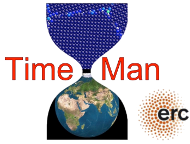
ERC Advanced Grant TimeMan, Rheology of Earth materials: closing the gap between TIME scales in the laboratory and in the MANtle
2018-2023
Most large-scale geological process such as plate tectonics or mantle convection involve plastic deformation of rocks. With most recent developments, constraining their rheological properties at natural strain-rates is something we can really achieve in the decade to come. Presently, these theological properties are described with empirical equations which are fitted on macroscopic, average properties, obtained in laboratory experiments performed at human timescales. Their extrapolation to Earth’s conditions over several orders of magnitude is highly questionable as demonstrated by recent comparison with surface geophysical observables. Strain rates couple space and time. We cannot expand time, but we can now reduce length scales. By using the new generation of nanomechanical testing machines in transmission electron microscopes, we can have access to elementary deformation mechanisms and, more importantly, we can measure the key physical parameters which control their dynamics. At this scale, we can have access to very slow mechanisms which were previously out of reach. This approach can be complemented by numerical modelling. By using the recent developments in modelling the so-called “rare eventsâ€, we will be able to model mechanisms in the same timescales as nanomechanical testing. By combining, nanomechanical testing and advanced numerical modelling of elementary processes I propose to elaborate a new generation of rheological laws, based on the physics of deformation, which will explicitly involve time (i.e. strain rate) and will require no extrapolation to be applied to natural processes. Applied to olivine, the main constituent of the upper mantle, this will provide the first robust, physics-based rheological laws for the lithospheric and asthenospheric mantle to be compared with surface observables and incorporated in geophysical convection models.
Interreg SOCORRO2
2020-2023
This project aims to provide companies with an independent means to assess the corrosion risks in their installations in sea water, to increase their awareness and to have them take appropriate preventive actions. To this end, we created a simple, rapid, in situ sensor system able to monitor a range of environmental markers over time to determine the risk of corrosion of steel submerged in water, as well as a statistical method to mine these data for an overall corrosion risk estimate – in short, the SOCORRO system. In this project, we will implement and demonstrate this whole set-up in several industrial case studies (wind turbines at sea, water desalination/sanitation, ship’s hulls and ballast tanks, harbour sheet piles, process water) and show the economic opportunities. In addition, we will augment the statistical analysis with an intuitive, practical dashboard tool to present the outflow of information and to convey that risk to the end users. The UMET / MPGM of the University of Lille is in charge of the characterization and understanding of the corrosion phenomena, in particular by surface characterizations (SEM, TEM Tof SIMS) of the samples produced in the project. The UMET / PIHM of the INRAe is in charge with its partner of university polytechnique des Hauts-de-France to evaluate whether an ultrasonic sensor presently used to monitor fouling formation can be used as a diagnosis tool to detect biofilm and predict corrosion formation.
RUSTINE (FUI) - Recyclage par extrUSion assisTée fluIde pour la valorisatioN de déchEts polymères
2018-2022
Le projet RUSTINE (Recyclage par extrUSion assisTée fluIde pour la valorisatioN de déchEts polymères) est un projet de recherche et développement collaboratif associant 4 entreprises (GALLOO PLASTICS, WIPAK, NUTRIPACK ET PSA) et 2 laboratoires académiques (UMET et ARMINES) dont l’objectif est le développement d’un procédé de décontamination de déchets plastiques issus de différentes filières. Le procédé qui sera étudié et développé au cours du projet est un procédé d’extrusion assistée fluides. Il s’agira d’identifier les paramètres clé qui régissent la dépollution sans dégrader le polymère. Le procédé sera étudié à différentes échelles : laboratoire, pilote et industrielle. L’enjeu global du projet RUSTINE consistera à produire un matériau recyclé répondant aux cahiers des charges des utilisateurs finaux à savoir le domaine de l’automobile et/ou de l’emballage alimentaire afin de contribuer à l’augmentation du taux de valorisation des plastiques recyclés. Le polymère ciblé dans le projet RUSTINE est le PolyPropylène (PP) largement utilisé dans le domaine alimentaire et dont les volumes collectés devraient augmenter avec la mise en place généralisé de l’extension des consignes de tri. La possibilité de proposer un PP recyclé, décontaminé alimentaire et/ou sans odeurs permettrait le développement d’une filière de valorisation du PP à haute valeur ajoutée et aurait pour effet un accroissement de la demande et un retour au choix de l’emballage PP pour certains acteurs enclins à s’orienter vers d’autres matériaux.
INTERREG GRASS - Gazons aRtificiels Anti-feu Sûrs et durableS
2018-2022
L'objectif du projet GRASS est de sensibiliser le public à la différence de comportement au feu entre gazon naturel et gazon artificiel et d'améliorer celui du gazon artificiel par le développement de procédés innovants, respectueux de l'environnement et applicables industriellement. Dans ce projet, on organisera une interaction constante avec un groupe de résonance au sein duquel installateurs, clubs sportifs, autorités et utilisateurs finaux sont représentés aux côtés des producteurs. L'implication de ce groupe de résonance offre la garantie que les innovations techniques issues de ce projet seront acceptables pour tous les acteurs du secteur des gazons synthétique - de la production à l'utilisation et jusqu'au recyclage - et seront mises en pratique.
ANR CLASSY
2018-2022
Our Solar System is the only planetary system that can be thoroughly explored by spacecrafts and by the analysis of planetary samples in the laboratory. It provides a unique glance at the mechanisms leading to stars and planets formation, a vision that is complementary to that derived from remote observations of nascent planetary systems. CLASSY aims at conducting experiments aimed at interpreting the spectral data from the ROSETTA, DAWN and NEW HORIZONS space missions. We will study experimentally the effects of the first stages of space weathering (ions irradiation) on the VNIR spectra of dark analogs, and investigate the composition and textural parameters that control VNIR spectra through multi-angular radio-spectro-goniometric measurements on sub-micrometric organics-minerals assemblages.
Interreg Allihentrop - Synthèse et mise en œuvre de revêtements à base d'ALLIages à Haute ENTROPie
2018-2022
Le projet ALLIHENTROP est porté par un consortium transfrontalier constitué de Materia Nova et du CRIBC (Mons) pour la Belgique, ainsi que du LAMIH (Université Polytechnique Hauts-de-France) et de l’UMET (Université de Lille) pour la région des Hauts de France. ALLIHENTROP propose de développer des revêtements à hautes performances (en termes de dureté, résistance au frottement, ductilité, tenue en température et résistance à la corrosion) formés d’Alliages à Haute Entropie (HEA). Le but est d'apporter une fonctionnalité à une pièce métallique, ou d'en améliorer les performances, et de valoriser ainsi des matériaux supports ou structurels à faible valeur ajoutée. Les méthodes de dépôt sont conçues de manière à être compatibles avec les processus de production industriels. La synthèse et la mise en forme de ces matériaux, ainsi que l'évaluation de leurs performances, requièrent une approche pluridisciplinaire faisant appel à des spécialistes de la modélisation, de la synthèse d’alliages complexes, des dépôts en couches de diverses épaisseurs et des caractérisations physico-chimiques.
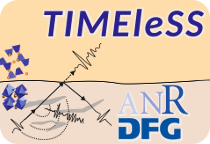
ANR-DFG TIMEleSS - Phase TransformatIons, MicrostructurEs, and their Seismic Signals from the Earth's mantle
2018-2022
The TIMEleSS project aims at studying interfaces in the Earth’s mantle combining observations from seismology, mineral physics experiments, microstructures, and wave propagation modeling. It is supported through a bilateral grant, from the ANR in France and the DFG in Germany with partners at Université de Lille, the Westfälische Wilhelms-Universität, Münster, and the Deutsche GeoForschungsZentrum, Potsdam.
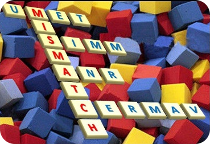
ANR MISMATCH -- MultIfunctional and Multi-sTimuli responsive Hydrogels
2018-2022
Le projet concerne l’élaboration d’hydrogels « intelligents » multi-stimulables et multifonctionnels. L’intérêt de l’approche supramoléculaire préconisée est, qu’en fonction du stimulus ou des stimuli appliqué(s), le matériau pourra répondre différemment et être utilisé pour différentes applications. Dans le cadre de ce projet, ces matériaux trouveront des applications plus particulièrement en tant que senseurs et/ou actuateurs.
ANR ECONOMICS
2017-2021
L’encrassement des surfaces des échangeurs de chaleur par des dérivés laitiers et ovo-produits constitue un risque sanitaire sévère. La modification de l'état de surface des échangeurs devrait permettre de limiter l'encrassement, mais aucune solution satisfaisante n'a été mise au point pour le moment. Le challenge du projet ECONOMICS est d'élaborer des surfaces et matériaux qui présentent à la fois une bonne compatibilité alimentaire, des propriétés anti-encrassantes et qui résistent aux procédures de nettoyage. La première voie consistera à fonctionnaliser l'acier inoxydable par des revêtements de faible rugosité et faible énergie de surface adhérents à l'acier inoxydable, de type : dépôt assisté par plasma atmosphérique, peintures auto-stratifiantes et revêtements sol-gel nanotexturés. La seconde voie consistera à remplacer l'acier inoxydable par des matériaux hydrophobes à base de carbone (composites carbone vitreux-graphite à énergie de surface et porosité contrôlées, composites hydrophobes à base de mousses de graphite, et carbone mésoporeux superhydrophobe à porosité contrôlée) de façon à réduire l'encrassement tout en améliorant l'efficacité énergétique des échangeurs. La dernière voie consistera à utiliser les matériaux hydrophobes poreux développés dans les deux autres approches (sol-gel et carbone mésoporeux) pour mettre au point des surfaces biomimétiques "SLIPS" (Slippery Liquid Infused Porous Surface) à faible hystérèse d'angle de contact, qui présentent un fort potentiel pour des applications anti-encrassement. Tous les matériaux et surfaces développés seront testés dans des conditions semi-pilote de pasteurisation de dérivés laitiers et ovo-produits. La durabilité des matériaux prometteurs sera ensuite évaluée, au travers de procédures de nettoyage-en-place (Cleaning in place). Le mécanisme d'action des surfaces à la fois efficaces contre l'encrassement et durables sera évalué à l'échelle nanométrique et micrométrique. Enfin, l'impact environnemental et le gain potentiel de ces matériaux par rapport au procédé classique seront évalués à travers une analyse de cycle de vie du procédé de pasteurisation. Ce projet regroupe des membres de l'UMET de différentes tutelles (ULille, ENSCL et INRA), de l'IEMN, de la Fédération Chevreul, de l'ULorraine,de l'UPHF et d'Agrocampus Ouest.
European project H2020 : GEMMA for GEneration iv Materials MAturity
2017-2021
The general objective of GEMMA Project is to qualify and codify the selected structural materials for the construction of Generation IV reactors, as envisaged within the European Sustainable Nuclear Industrial Initiative (ESNII). The contribution of UMET covers as well atomic scale simulation studies as mesoscopic scale experimental ones. The density functional theory is used to determine the necessary data required developing a kinetic model of Ni-Cr under thermal conditions and the effect of Fe as a dilute species will be then considered. Due to its recognized expertise in the field of liquid metal embrittlement of structural materials, UMET plans to investigate the mechanical behaviour of new alumina forming austenitic steels and of the 15-15Ti steel in liquid lead and in liquid lead-bismuth at temperatures up to 500°C.

ERC Advanced Grant FireBar-Concept, Multi-conceptual design of fire barrier, A systemic approach
2016-2021
The development of science and technology provides the availability of sophisticated products but concurrently, increases the use of combustible materials, in particular organic materials. Those materials are easily flammable and must be flame retarded to make them safer. In case of fire, people must be protected by materials confining and stopping fire. It is one of the goals of the FireBar-Concept project to design materials and assembly of materials exhibiting low flammability, protecting substrates and limiting fire spread. The objective of FireBar-Concept is to make a fire barrier formed at the right time, at the right location and reacting accordingly against thermal constraint (fire scenario).
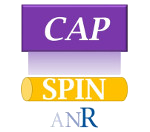
ANR CAPSPIN - Implants anti-adhérents et antimicrobiens pour la chirurgie viscérale élaborés par plasma froid atmosphérique et electrospinning
2017-2021
The aim of CAPSPIN project is to combine and optimize through experimental design two eco-friendly processes for the elaboration of antiadhesive and antimicrobial biodegradable nanofibers coated onto intraperitoneal polypropylene implants. Electrospinning process is an innovative process used to produce biodegradable monolithic and core-sheath nanofibres. Atmospheric cold plasma technology is used for the activation and functionalization of different polymeric substrates at the extreme surface only.
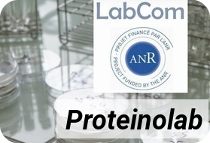
Proteinolab
2018-2021
Proteinolab : un laboratoire commun UMET-Ingredia dont la feuille de route est centrée sur le développement d’Isolat de protéines de lait différentiées optimisant la fonctionnalité des produits hyperprotéinés, en particulier des boissons nutritionnelles. Ces innovations produits et leurs pilotages passent entre autre par une meilleure compréhension des relations Structures et Fonctions des protéines.
Interreg Valbree
2018-2020
Les PBDE (polybromodiphényléthers) et les PBB (polybromobiphényles) font partie des molécules largement employés par le passé pour l'ignifugation de plastiques d'équipements électriques et électroniques entre autre. La directive phare du traitement des déchets (2012/19/UE) impose un traitement sélectif des matières plastiques chargées en Retardateurs de Flamme Bromés (RFB), après extraction du flux des plastiques non bromés. Ces plastiques ne peuvent donc plus être recyclés, enfouis ou exportés sans un traitement préalable garantissant l'élimination des molécules ciblées. A cette heure, le traitement séparé de certains plastiques bromés reste extrêmement difficile pour des raisons réglementaires, techniques et financières. Aucune solution respectueuse de l'environnement n'existe pour revaloriser ces plastiques chargés de RFB. Aucun procédé industriel, à notre connaissance, ne peut être recensé pour la décontamination des plastiques bromés. Grâce à la mise en commun de compétences uniques en région du CREPIM, de l'Université Lille 1/CNRS, du VKC/CENTEXBEL et de MATERIANOVA, ce projet permettra de développer une technologie, dont le principe a été breveté par les deux premiers partenaires, pour accompagner et soutenir concrètement les entreprises en charge de déchets de plastiques contenant des RFB. Cette technologie, qui s'articule autour de l'action des radiations UV, permettra aux industriels de la région transfrontalière de traiter à  coût réduit tout type de plastique contenant des RFB et de valoriser ce gisement jusque-là perdu.
PYROCAT Equipe-Mixte / Etude du procédé de PYROlyse CATalytique de déchets Polymères
2017-2020
Depuis le 1er septembre 2017, des chercheurs de l’Institut Chevreul (Laboratoires UMET et UCCS) et des industriels de Néo-Eco et Valorplast travaillent ensemble au sein d’une équipe mixte intitulée PYROCAT. PYROCAT a pour objectif d’étudier la pyrolyse catalytique de déchets de polymères en vue de permettre une valorisation matière (retour aux monomères ou à des molécules d’intérêt pour la pétrochimie) ou une valorisation dans le domaine de l’énergie (retour à un pseudo-pétrole) de ces déchets. Les ambitions scientifiques de cette équipe mixte sont orientées autour de trois grands axes scientifiques : (i) le développement de matériaux catalytiques pour la pyrolyse de déchets polymères, (ii) l’étude multi-échelle du procédé de pyrolyse catalytique et (iii) l’analyse de l’impact environnemental du procédé. Cette équipe s’est structurée afin de répondre avec succès à l’appel à projet EMILE (Équipes mixtes Laboratoire-Entreprise) dans le cadre du Programme Opérationnel FEDER pour le Nord-Pas de Calais 2014-2020 (édition 2017). Elle est également labellisée par le pôle de compétitivité Team2.
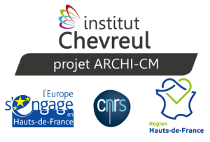
CPER ARCHI-CM
2014-2020
L'UMET est impliqué dans le projet CPER ARCHI-CM, porté par la fédération Chevreul. Ce projet vise à répondre à des défis sociétaux, dans les domaines de la bio-économie, de la réponse aux défis énergétiques et des matériaux avancés. C’est un projet interdisciplinaire, dont la spécificité scientifique réside dans la combinaison des concepts d’architectures à la fois pour réaliser des matériaux innovants (assemblages de blocs fonctionnels, texturation multi-échelle, …) et pour induire des réactivités chimiques originales (milieux confinés, catalyseurs multifonctionnels,…).
Interreg_transport - Réseau TRANSfrontalier pour le développement de revêtements sol-gel POReux sur métaux pour applications Tribologiques
2016-2020
Les secteurs du transport (aéronautique, aérospatial, ferroviaire, automobile, outillages, mécanique et sous-traitants) sont des secteurs très développés de part et d’autre de la zone frontalière. Pour ces secteurs, la qualité (longévité et fiabilité) des pièces métalliques est primordiale, celles-ci devant résister aux frottements, à l’usure, à la corrosion et à de fortes contraintes de températures. Les matériaux performants existants sont souvent onéreux, et ne répondent pas aux besoins des industriels car ils ne combinent pas la résistante à l’usure et à la corrosion. Dès lors, la demande du marché est très forte pour des pièces plus performantes, moins onéreuses, et qui seront résistantes à la fois aux phénomènes d’usures et de corrosion.Dans ce contexte, le projet vise à développer des revêtements céramiques poreux par voie sol gel déposés sur des substrats métalliques. Ces revêtements contiendront à la fois des lubrifiants (liquides ou solides) et des inhibiteurs de corrosion en vue d’obtenir des matériaux à haute performance, durables et résistants dans toutes les applications où les pièces métalliques sont soumises à des frottements et contraintes. Les principales actions du projet TRANSPORT seront de mettre en œuvre et tester ces pièces (où les revêtements sol gel à faible coefficient de frottement développés seront déposés), d’abord à l’échelle laboratoire, puis à l’échelle pilote, pour ensuite développer des solutions répondant aux attentes du marché via une démarche collaborative fortement orientée vers l’applicatif en associant dès le départ les partenaires industriels demandeurs.

ANR NanoPiC - Etude du comportement piézoélectrique multi-échelles de composites innovants micro- et nano-structurés
2016-2020
Le projet NanoPiC a pour objectif de mener un programme de recherche et de développement de matériaux piézoélectriques innovants et ayant des propriétés améliorées, à partir de composites céramiques - polymère structurés. Il s’agit d’une part de fabriquer des composites comportant des domaines micro- et nano-structurés de céramiques non toxiques et de polymère fluoré et d’autre part de caractériser le comportement piézoélectrique aux échelles macroscopique et nanoscopique. La compréhension des comportements piézoélectriques de ces matériaux composites structurés est un enjeu scientifique fort et ouvre la voie à l'utilisation de ces matériaux pour des applications dans le domaine des pMUT (piezoelectric Micro machined Ultrasonic Transducers).
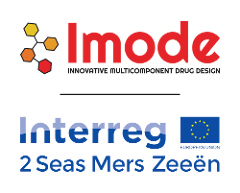
Interreg Interreg Imode - Innovative Multicomponent Drug Design
2016-2020
A collaborative research on multicomponent pharmaceutical products (co-amorphous and co-crystals) and medical devices loaded with bioactive molecules. IMODE is funded by the European Interreg 2 Seas programme and cofinanced by the European Fund for Regional Development (ERFD).
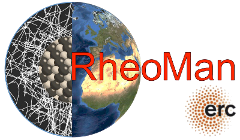
RheoMan: a five-year, ERC-funded (Advanced Grant), project to model the rheology of the Earth's mantle
2012-2018
The goal of RheoMan is to model the rheology of the Earth’s mantle from the properties of its constitutive minerals and rocks. It proposes a novel approach based on multiscale modelling of rheology. The goal of multiscale modelling is to link our understanding of a few elementary mechanisms (usually at the microscopic scale) with a behaviour observed at the macroscopic scale. In solids, plastic deformation results from the motion of crystal defects: point defects, dislocations, grain boundaries.
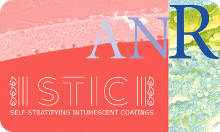
ANR STIC - Self-stratifying Intumescent Coatings
2014-2017
Replace the traditional (Primer/Coating/Topcoat) process by formulating a self-stratifying coating showing: adhesive properties to a substrate, good durability when submitted to accelerated aging tests, flame retardancy. Objectives: increase fire retardant effect on plastics (Polycarbonate), increase fire protective effect on steel structure.
